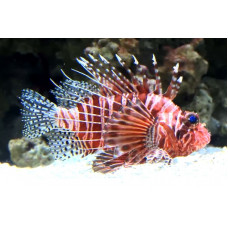Latin name
Pterois mombasae
Other name
Deepwater firefish, frillfin turkeyfish
Identification
The species name mombasae is derived from the African city of Mombasa. Those living in the Pacific Ocean are recognised as a separate species.
Features of fish fins
Dorsal spines (total): 13; Dorsal soft rays (total): 10; Anal spines: 3; Anal soft rays: 6 - 7.
Fish colouring
This is a brightly coloured fish. It is red with white and brown horizontal stripes all over the body and fins. The dorsal and pectoral fins have long, poisonous, brightly coloured barbs.
Distribution
Widespread in the Indian Ocean.
Habitat
It is a tropical marine species that lives on coral reefs at depths of up to 70 metres.
Size
They are medium sized fish 20-31 cm long.
Behavior
Occupies the continental shelf. A rare inhabitant of the rocky bottoms of deep-water coastal reefs. Usually found on soft bottoms or muddy substrates with large amounts of detritus, among rich vegetation of invertebrates, especially sponges. Also found among soft corals, singly or in small groups.
Food and feeding habits
An active predator, it feeds on small fish and crustaceans.
Reproduction
Female African lionfish lay mucus-filled eggs. They can lay up to 2 million eggs a year.
Fishing
This species is of minor commercial importance in fisheries.
Relationship with a person
Harmless. Sold fresh in small quantities at markets.
| Classification | |
| Phylum | Chordata |
| Class | Actinopterygii |
| Squad | Scorpaeniformes |
| Family | Scorpaenidae |
| Genus | Pterois |
| Species | P. mombasae |
| Features | |
| Conservation status | Least Concern |
| Habitat | Pelagic |
| Life span, years | No information |
| Maximum body weight, kg | No information |
| Maximum length, cm | 31 |
| Sailing speed, m/s | No information |
| Threat to people | Edible |
| Way of eating | Predator |
African lionfish
Tags: african lionfish



